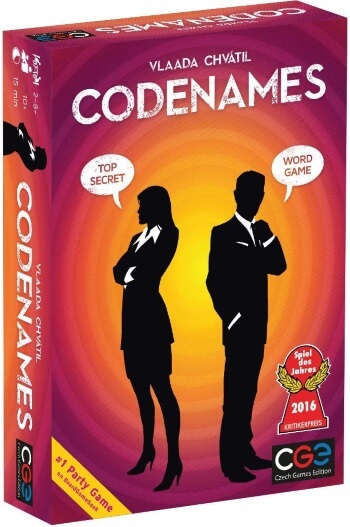Codenames at a Glance
| Game Type Team Based, Word, Deduction, Memory, Push Your Luck | Play Time 15 mins (approx) | Skill/Complexity (1.5 - 5) Light |
| Age 14+ | Publisher(s) Czech Games | Published 2015 |
| Categories Family Party / Word | Players 2 - 8 + (best 6 - 8) | Rules Manual Official Rules |
| Our Rating 9/10 | Cost $19.99 approx | Related Codenames Duet Games Like Codenames |

About – Description
Czech Games first published Codenames tabletop card game in 2015 and it soon became a top hit within the word, party and card game genres.
The Spiel des Jahre award for best board game of 2016 went to Codenames and it picked up many other awards and honors from its year of being published (2016) to 2017. It certainly has made an impression on gamers including the best of the geek critics.
The age rating is 14+ and 2 – 8 or more players can play, although I have found it works best with 6 or 8 players. Each game lasts approximately 15 minutes.
– Here’s a bunch of games like Codenames worth checking Out »
Who’s it best suited for?
Codenames is a two team game where the two teams compete against each other which makes it ideal for parties, groups or family occasions. To be fair it’s open to a wide audience, especially those that play word based games.
Skill – Complexity
There’s not a huge amount of skill involved. It’s at the lower end of complexity in comparison to strategy type games. It ‘s much more about fun than complexity.
Being smart at picking up word hints as a clue is an advantage to direct players to the agents (operating undercover) operatives (players other than the spymaster) need to find.
Set Up – Playing Rules & Instructions

Setting up is as straight forward as a game can get……
Lay out 25 code named cards that each have a word on them. Each card represents agents, red and blue, bystanders and the assassin. You’ll have 40 keycards for spymasters to choose from for each game, 200 cards with 400 codenames, and 16 agent cards with an extra double agent card (this one is for who starts the game off).
Don’t make contact with the assassin or it’s bye bye for your team and you sadly lose if you do.
In Codenames you play as members of two competing spy networks, communicating in code to contact your secret agents while avoiding the not so friendly assassin.
The goal of the game is to win by being the first team to contact all of their secret agents.
The game is played on a 5 by 5 grid of words (cards), representing the codenames of secret agents such as Jack, Moscow, and Diamond for example.
Each team has one spymaster, with the rest of the team playing as Operatives.
At the start of the game , the two spymasters draw one key card to share. This card is for spymasters eyes only, and shows them which codenames are on the grid that belong to the teams.
The team whose color borders the key card goes first, but has one more agent to contact than the opposing team. This is the extra agent card mentioned.
So, 8 of these agents belong to one team, 9 belong to the opposing team and 1 is the not so friendly assassin, and the rest are innocent bystanders.
As an operative, your goal is to contact agents based on the clues your team spymaster gives you.
Each turn your spymaster can say one word and one number (the clue and the number of codenames on the board that clue apples to). For example if your spymaster says Animal 3, he might be suggesting 3 animal types that are on the cards.
Operatives (players) then guess which cards the spymaster is providing clues for. The agent that is revealed has its identity card placed on top of the word. If you do point out one of your teams agents then you can continue guessing up to the number suggested by the spymaster, or you are able to pass. If you touch a card that does not belong to your team then your turn is over.
It you point out an innocent bystander, nothing happens, but you could accidentally give a point to the other team. Or you could get the assassin and end the game abruptly causing your team to lose.
Once one teams cards (agents) are revealed that team wins.
Note: Spymasters are given certain rules on how to give clues to their team in order to prevent spymasters giving clues that are way to obvious and revealing. The rules sheet is straight forward in explaining these.
Versions – Editions
There are plenty of language translated versions and a fair few editions. Editions includes Codenames, Pictures, Duet, Disney, Marvel, and Deep Undercover 2.0.
Likes & Dislikes
It ‘s hard to find anything to dislike abut the board game Codenames. It’s a lot of fun, simple, easy to set up, non-expensive, has short play time and plenty of card options to prevent repetitiveness.
I would not rank or see this as a highly engaging party game as there has to be many silences compared to other party games, so I would point more towards groups and people or families getting together to play. It is still fun though and you don’t have to be too serious.
It’s a nice theme (spying) but I never kind of feel like I am a spy while playing, but this does not affect that it’s a great game.
Final Thoughts
For those that like simplistic games where you play in teams involving word clues and getting together with others without setting up a game that goes on for hours – Codenames is ideal.
– We’ve put together a bunch of games similar to Codenames worth checking Out »


